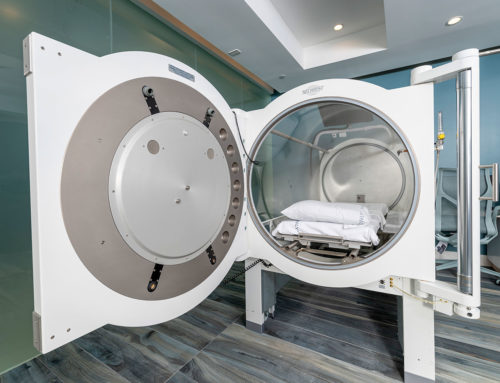Hyperbaric oxygen therapy (HBOT) is a treatment method that involves breathing in pure oxygen while relaxing in a pressurized chamber. It is used to treat a wide range of conditions, from crush injuries and infections to carbon monoxide poisoning and anemia. At Aalto Hyperbaric, we offer high-quality HBOT sessions in our state-of-the-art chambers. Here are seven conditions and their symptoms that may be managed with hyperbaric treatment:
1. Decompression Sickness
Decompression sickness, or “the bends,” occurs when dissolved gases like nitrogen form bubbles in the bloodstream as a result of rapid decompression. It can be caused by ascending too quickly from deep water during scuba diving or descending from high altitudes in aviation. The resulting bubbles cause various symptoms depending on their size and location. One of the most common symptoms is severe joint pain throughout the body. Other effects of decompression sickness include headaches, dizziness, fatigue, shortness of breath, and ear ringing. HBOT is a primary treatment for decompression sickness. It works by reducing the size of the bubbles and increasing the elimination of nitrogen from the body. The treatment also relieves painful swelling and inflammation while increasing oxygen delivery to affected tissues, promoting healing and recovery.
2. Anemia
Anemia is a condition characterized by a deficiency of red blood cells or hemoglobin in the blood. It leads to reduced oxygen-carrying capacity and impaired oxygen delivery to tissues. Some symptoms of anemia are noticeable fatigue, headaches, difficulty breathing, and irregular heartbeats. Our hyperbaric treatment process is an FDA-approved method for addressing severe and chronic anemia, including sickle cell anemia. HBOT floods the body with oxygen, promoting tissue oxygenation for symptom relief.
3. Carbon Monoxide Poisoning
Carbon monoxide (CO) poisoning occurs when CO gas is inhaled, leading to its absorption into the bloodstream. This gas is difficult to detect as it is colorless, odorless, and tasteless. It is found in the combustion fumes released by fuel-burning appliances like cars and furnaces. Symptoms of CO poisoning include confusion, dizziness, headache, nausea, and vomiting. HBOT is an effective treatment for reducing the effects of CO poisoning. It helps eliminate carbon monoxide from the bloodstream and body tissues while increasing the amount of available oxygen available in the body.
4. Aging
Aging can be associated with a range of symptoms and health challenges. These symptoms include reduced blood circulation, skin elasticity, and mental clarity. Aging can also cause fatigue and joint pain. Hyperbaric therapy may be used to manage these symptoms and promote healthy aging. The increased oxygen from treatment helps regrow blood vessels and improve blood circulation, stimulating tissue renewal. HBOT aids in easing joint pain and fatigue by reducing inflammation and stimulating energy levels. Enhancing overall oxygen availability allows the body to increase collagen production, promoting skin elasticity and smoothness. HBOT may also improve mental clarity and mitigate age-related cognitive decline by increasing oxygen delivery to the brain.
5. Rheumatoid Arthritis
Rheumatoid arthritis is an autoimmune disorder that affects the joints, leading to inflammation, pain, stiffness, and damage. It can also involve other parts of the body, such as the skin, eyes, and blood vessels. While HBOT is not a primary treatment for rheumatoid arthritis, it offers some benefits as an adjunctive therapy in managing specific symptoms associated with the disease. Hyperbaric treatment has anti-inflammatory properties and has been shown to reduce inflammation in various conditions. By decreasing inflammation in the joints, HBOT may alleviate swelling and discomfort associated with rheumatoid arthritis, improving joint function and mobility.
6. Depression
Depression is a mental health disorder characterized by frequent feelings of sadness, hopelessness, and a loss of interest or pleasure in activities. A range of physical and emotional symptoms can also accompany this condition. These include irritability, fatigue, difficulty concentrating, changes in sleep and appetite, and chronic pain. Research suggests that HBOT yields similar effects to psychotherapy when used for treating depression. It may enhance neuronal and cognitive function, potentially making it easier for individuals with depression to cope with daily activities and responsibilities. Hyperbaric treatment provides the brain with additional oxygen, potentially reducing brainwave imbalances and encouraging stem cell growth.
7. Lyme Disease
Lyme disease is a tick-borne illness caused by the bacterium Borrelia burgdorferi. The symptoms of Lyme disease in humans vary depending on the stage of the infection. One of the first indications is a red rash, which can be followed by flu-like symptoms. Some cases result in nerve damage, muscle and joint pain, and chronic inflammation. HBOT may be an effective way to manage this condition and its various symptoms. The bacteria that causes Lyme disease is anaerobic, meaning it cannot survive in an oxygen-rich environment. Hyperbaric treatment works alongside antibiotics to kill off this harmful bacteria. HBOT can also stimulate tissue repair and reduce inflammation caused by the disease.
Schedule Hyperbaric Treatment at Aalto Hyperbaric
Aalto Hyperbaric uses HBOT to treat conditions like anemia, depression, and arthritis. The increased oxygen levels help individuals manage many symptoms, including inflammation and tissue damage. Our single-person hyperbaric chambers use 100% pure oxygen, providing a private and personalized treatment experience. Contact us today to learn more about our hyperbaric treatment services.
RELATED POSTS
GET STARTED TODAY
Schedule an appointment with us today by calling (310) 507-7942 or using the contact form below.discover thisread what he saidelfbar 3500company website


